BOV - it all started with the "Black Fog"
In 1944, the Third Reich was steadily approaching its demise, Germany was clinging to any, even a ghostly, hope of changing the course of the war, trying to realize the most impracticable and fantastic projects. One of such projects was the project called “Schwarzenebel” (“Black Fog”).
The initiator and main developer of this project was an inconspicuous railway employee named Johann Engelke, who had only four classes of the urban school, but who had a clever cunning and adventurous. He appealed to the Ministry of Arms of Germany with the idea of a supposedly effective air defense system.
In his project, he proposed to use the effect of one known phenomenon, which in our time is called the effect of a volumetric explosion.
People have long paid attention to one sad circumstance - often the most peaceful production: carpentry workshops, coal depots, granaries, empty tanks of oil and kerosene, and even confectionery factories — were blown apart by explosions, which were much stronger than normal explosives. The cause of these explosions, as it turned out, was the ignition of a mixture of air and combustible gas or suspension of dust of combustible substances. The burning process in a very short time immediately covered a very large amount of matter, and flour, sawdust, or powdered sugar exploded, smashing everything into splinters.
The essence of Engelke’s idea was that according to the course of the enemy bomber groups, which usually flew in a dense “box-commander” formation, he proposed using U-88 to disperse fine coal dust and set fire to it with rockets fired from the same U-88 at the time of entry enemy planes in a coal cloud.
The command of the Third Reich found this idea feasible and gave the go-ahead to carry out work on the project.
Engelke was “successful” over this project and worked until April 1945. Although, as work progressed, it turned out that to create the necessary concentration of a coal cloud into the air, it was necessary to raise at least two times more planes than it was supposed to destroy.
After the capitulation of Germany, Engelke was arrested by the Allies, whom he, posing as a physicist and presenting a certificate of an employee of the Ministry of Arms, offered his services.
He was placed at the disposal of the leadership of the national nuclear program, as he worked in the German Ministry for the production of “heavy water”. Here the "inventor" was quickly exposed, and he was driven out of service in disgrace. The idea of using the effect of a voluminous explosion for military purposes was forgotten for almost two decades later.
By the beginning of the 60s of the last century, the US military became interested in the effect of a volumetric explosion. For the first time they used such ammunition in Vietnam for engineering purposes.
Under the conditions of impassable Vietnamese jungle, the supply and transportation of troops were difficult and often due to the lack of seating places simply impossible. Clearing the site for helicopters took a lot of time and effort.
Therefore, it was decided to use bombs with the effect of a volumetric explosion for clearing the sites. The effect surpassed everything, even the wildest expectations - one such bomb was enough to create a quite suitable landing platform even in the most impassable forest.
BLU-73 — the very first volume explosion bombs got this name, they were loaded with 33 – 45 with liters of ethylene oxide and dropped from a small height to 600 m. A moderate parachute provided a moderate speed of movement and stabilization. The undermining was performed by a tension fuse — a thin cable, 5 – 7 long and with a sinker, was lowered from the nose of the bomb, releasing the firing pin lever when in contact with the ground. After that, the initiating warhead was activated, generating a cloud of a fuel-air mixture with a radius of 7,5 – 8,5 meters and a height of up to 3 meters.
These bombs were first used by the US military for engineering purposes only. But soon the US military began to use them in battles with partisans.
And again, the effect exceeded all expectations. A cloud of sprayed fuel gave rise to an enormous power of the blast wave and burned everything around, while it also flowed into leaking shelters and dugouts. The injuries inflicted on people in the affected area were incompatible with life; the American military medics christened them “the effect of a bursting frog”. In addition, (especially at first), the new bombs had a great psychological effect, causing panic and horror in the ranks of the army of Ho Chi Minh.
And although in the years of the Vietnam War from 13 000 000 tons of spent ammunition, the share of second-hand weapons is negligible, just by the results of Vietnam new weapon It was recognized in the Pentagon very promising.
Traditionally, the US military have focused on air bombs.
During the 70-ies in the United States actively developed ammunition with the effect of a volumetric explosion of various designs, masses and fillings.
To date, the most common American ODAB (space-detonating aerial bomb) are BLU-72 “Pave Pat-1” - 500 kg, curb 450 kg of propane, BLU-76 “Pave Pat-2”; BLU-95 - mass 200 kg and charge in 136 kg propylene oxide and BLU-96, curb 635 kg propylene oxide. "Veteran of Vietnam" BLU-73 is also still in service with the US Army.
The creation of ammunition for missile systems was also crowned with success, in particular, for the Zuni 30-barrel MLRS.
As for the infantry weapons, in the United States paid him not a lot of attention. Thermobaric missiles were made for the M202A2 FLASH hand-held flamethrower, as well as similar ammunition for grenade launchers, for example, for X-25. And only in 2009, the work on the projectile for MLRS MLRS with thermobaric warhead mass from 100 to 160 kg was completed.
To date, the most powerful ammunition in the US Army and on a global scale is the GBU-43 / B ammunition of volume explosion, whose second official name is Massive Ordnance Air Blast or, in abbreviated form, MOAB. This bomb was designed by Boeing designer Albert Wimorts. Its length is 10 m, diameter –1 m. From 9,5 t its mass 8,5 t is explosive. In 2003, the US Air Force conducted two test bombs at a test site in the state of Florida. During Operation Enduring Freedom, one copy of the GBU-43 / B was sent to Iraq, but it remained unused — by the time it was delivered, active hostilities were over. For all its merits, the GBU-43 / B has a significant disadvantage - its main carrier is not a combat aircraft, but the military transport Hercules dropping a bomb on the target through a loading ramp, that is, it can be used only if the enemy lacks air defense or completely depressed.
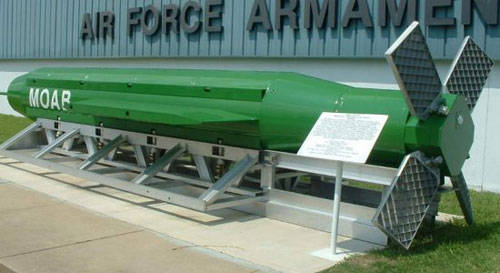
In 1976, the UN reacted to the emergence of a new type of weapon, a resolution was passed declaring the ammunition of a volume explosion "inhumane means of warfare, causing excessive human suffering." In 1980, an additional protocol to the Geneva Convention was adopted, prohibiting the use of CWA "in places where civilians gather."
But this did not stop the work on the creation of new types of ammunition for a volumetric explosion, or their use.
Around the same time, vacuum munitions began to appear in the US allies - the British were the first. Then they were acquired by Israel, which even managed to put them into practice: in 1982, during the war in Lebanon, an Israeli plane dropped an American-made BLU-95 BOV to an eight-story apartment building, nearly three hundred people were killed, the house was completely destroyed.
Other US allies at various times also acquired small batches of such munitions.
The development (copying) based on foreign designs and the production of this type of weapon in the PRC are successfully developing. China has actually become the third country in the world that independently produces this type of weapon.
The Chinese army is currently armed with a whole range of volumetric explosive ordnance. Air bombs - analogues of the Russian ODAB-500, shells for multiple launch rocket systems, for example, for ultra-long-range WS-2 and WS-3, whose radius of destruction is up to 200 km, aviation missiles - including for the widely exported J-10.
Standard thermobaric shots for Type-69 and Type-88 grenade launchers, as well as special missiles with thermobaric warhead for firing from these Norinco grenade launchers weighing 4,2 kg and with a maximum range of up to 1000 m, are produced in large numbers. combat WPF 2004 company Xinshidai Co with thermobaric charge, with an effective range of 200 m.
At distances in 3000 – 5000 and Chinese artillery, it can meet the enemy Red Arrow 8FAE - a rocket propeller with a mass from 50 to 90 kg with a warhead with a mass up to 7 kg, equipped with ethylene oxide.
There are PLA and analogues (not copies) of the Russian RPO "Bumblebee" - PF-97 and lightweight FHJ-84 caliber 62 mm.
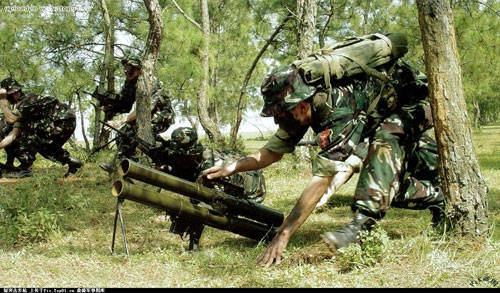
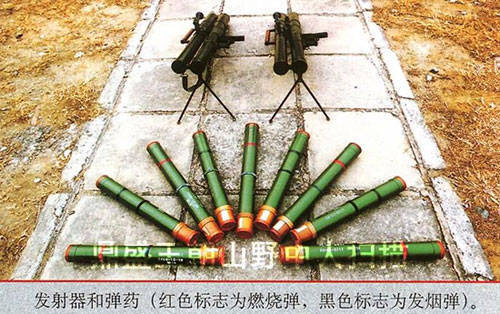
According to available information, the Chinese intend to equip their newest medium-range DF-21 rocket warheads with a satellite-guided target.
At various times, Iran, Pakistan and India have declared their intention to start production of such munitions.
In 1990, rebels and terrorists of all stripes and calibers became interested in these weapons. In Colombia, partisans repeatedly used improvised mortar mines made from household gas cylinders with makeshift stabilizers and a ceramic nozzle instead of a sprayer.
According to some unconfirmed data, at the end of 1990-ies in Chechnya, by order of Maskhadov, the issue of using the Smerch MLRS combat units for dropping from light aircraft was considered.
In Afghanistan, after the capture of the famous Taliban fortress of Tora Bora, the US military discovered the schemes of thermobaric charges and samples of mixtures of flammable liquids. Remarkable is the fact that during the storming of the fortress, the US military used the BLU-82, at that time the most powerful ammunition that had the name “Daisy mower”.
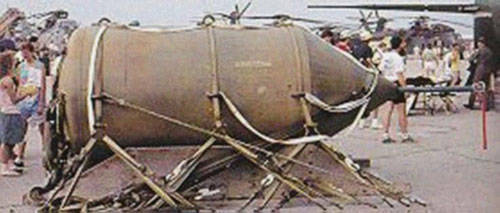
"Daisy mower"
It is interesting that in the matter of theoretical studies of the effect of a volumetric explosion, Soviet scientists were the first to solve this problem while working on an atomic project.
Kirill Stanyukovich, a prominent Soviet physicist, was concerned with the detonation of gas mixtures, as well as converging spherical shock and detonation waves, which served as the theoretical basis for the principle of implosion inherent in the operation of nuclear weapons in the middle of the 1940-s.
In 1959, the fundamental work “Physics of the explosion” was published under the general editorship of Stanyukovich, where, in particular, many theoretical questions of the volume explosion were developed. This book was in the public domain and was published in many countries of the world, it is possible that US scientists have learned a lot of useful information from creating this book when creating “vacuum” ammunition. But, nevertheless, as in many other cases, having a great superiority in theory, in practice we are lagging behind the west.
Although, taking up this issue, Russia rather quickly managed not only to catch up, but to overtake all foreign competitors, creating an extensive family of weapons, ranging from infantry flamethrowers and ATGM with a thermobaric warhead and ending with warheads to short-range missiles.
Like the potential enemy, the United States, aerial bombs became the main direction of development. Above them worked one of the largest experts in the field of explosion theory, Professor of the Air Force Engineering Academy named after NE Zhukovsky, Leonid Odnovol.
The main models for the middle of 1980-x were ODAB-500P (the most popular sample), KAB-500Kr-OD (with telenovedenie), SLM-OD BLU (container with volume-detonating 8-cluster bombs).
In addition to the aerial bombs, shells were created for the Smerch and Uragan multiple rocket launchers, which had no analogues in TOC-1 Buratino, the Sturm and Ataka helicopters, the C-8D aircraft (C-8DM).
The infantry weapons didn’t ignore either - the Kornet-E long-range anti-tank guided missile complex and the Bumblebee rocket-launched infantry flamethrower entered the Army’s armament. Also created thermobaric ammunition for the traditional RPG-7 - shot TBG-7В. At the end of the 1980-x, even the RG-60TB volumetric explosion hand grenades and grenades for the under-barrel grenade launchers VG-40TB with a caliber of 40 mm and with a range of up to 400 meters appeared.
The development of mine-sabotage systems was also actively pursued, but the collapse of the USSR stopped work at the theory stage.
Emerging new products very soon passed the baptism of fire in Afghanistan, where bombs and thermobaric shells were actively used for the MLRS. The bombs ODAB-500P were used during the landings of the helicopter assault, for the clearance of the sites, and also against the enemy manpower.
The use of such ammunition as well as in Vietnam had a considerable psychological effect.
A volume-detonation weapon was used in both Chechen wars, and on both sides: the militants used captured Bumblebees.
In August, 1999, in the period when terrorists attacked Dagestan, a large-volume bomb exploded on the village of Tando captured by militants. The bandits suffered huge losses. In the following days, the mere appearance of a single Su-25 attack aircraft over any settlement forced the militants to hastily leave the village. There was even a slang term "Tando effect".
During the storming of the village of Komsomolsk, Buratino’s TOC-1 batteries were used, after which the special forces occupied it without much difficulty and with minimal losses.
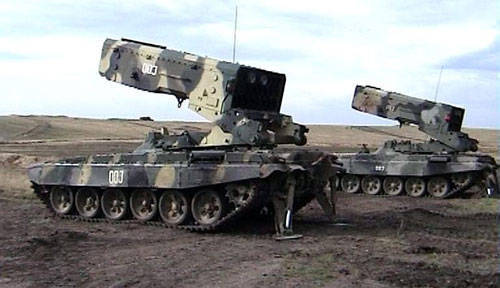
TOC-1 "Buratino"
In the two thousand years, after a long break, Russia began to create new types of ammunition for a volume explosion. For example, the multi-caliber weapon complex RPG-32 (aka “Hashim”), whose ammunition includes 105-mm grenades of a volumetric explosion.
In the autumn of 2007, new Russian super-power aerial bombs were tested, which the media dubbed “the father of all bombs”. The bomb has not received the official name yet. It is known that nanotechnology was used for its manufacture. The Russian bomb per ton is lighter than its closest US analogue of the bomb GBU-43 / B, while it has a fourfold larger radius of guaranteed destruction. With a mass of explosives in 7,1 T, the TNT equivalent of an explosion is 44 T. The temperature at the epicenter of the explosion at the Papa Bomb is twice as high, and it surpasses the GBU-43 / B almost 20 times. But so far this bomb has not entered service, and it is even unknown if any work is being done in this direction.
In the current year in terms of constant readiness will come rocket infantry flamethrowers of the new modification - RPO PDM-A "Shmel-M"
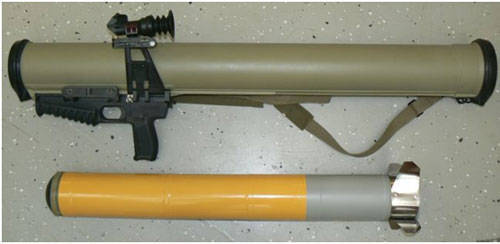
But, despite its high combat effectiveness, combat weapons have a number of significant drawbacks. For example, they have only one damaging factor - the shock wave. They do not possess and cannot have a cumulative and fragmentation action.
The blasting effect — the ability to destroy an obstacle — is quite low in thermobaric ammunition. Even well-sealed field fortifications can be a pretty good defense against a DOM explosion.
Modern hermetically sealed armored vehicles and Tanks they can also easily withstand such an explosion, even being at its epicenter. That is why BOV has to be supplied with a small cumulative charge.
At medium altitudes, where there is little free oxygen, the phenomenon of a volume explosion is difficult, and at altitudes greater, where there is even less oxygen, it is impossible at all (which practically excludes the air defense sphere). In case of heavy rain or strong wind, the cloud either dissipates strongly or does not form at all.
It can also be noted that in none of the conflicts where BOV was applied, they did not bring any strategic, or even substantial tactical gain, except, perhaps, a psychological effect.
These munitions are not precision weapons of the “fifth generation wars”.
However, in spite of all of the above, the BOV is likely to take a prominent place in the arsenals of armies in many countries of the world for a long time.
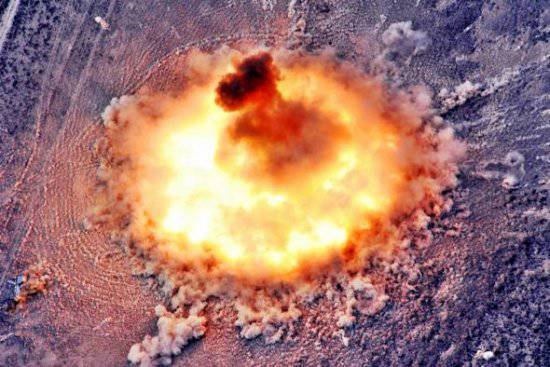
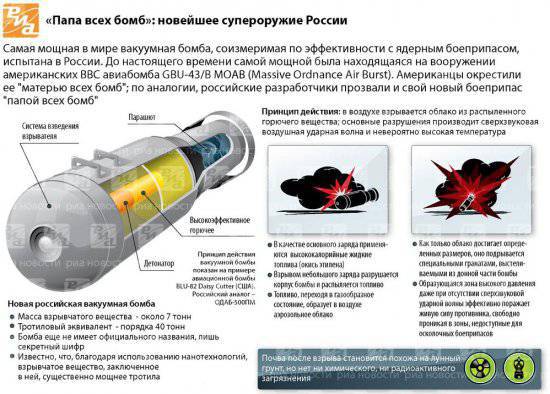
Information